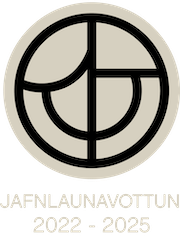Norvagismar í íslenskum handritum frá 1350 til 1450 - verkefni lokið
Fréttatilkynning verkefnisstjóra
Þessi rannsókn veitir víðtækt yfirlit yfir þróun og áhrif norskra málaeinkenna, svokallaðra norvagisma, í 75 íslenskum handritum og frumritum frá fjórtándu öld og fram að siðaskiptum. Þessi einkenni eru
algeng í kirkjulegum, hagíógrafískum, lagalegum og stjórnsýslulegum skrifum, sem bendir til þess að þau hafi hlutverki að gegna sem stílmerki í formlegum skrifum.
Þessi rannsókn lagði einnig áherslu á
félagslegt og svæðisbundið samhengi og leiddi í ljós mun á milli hópa ritara sem bendir til tilvistar
mismunandi svæðisbundinna stafsetningarvenja. Rannsóknin kannaði frekar áhrif plágunnar árið 1402 og yfirtöku handritaframleiðslunnar af félagslegu yfirstéttinni. Þetta verkefni stuðlar þannig að skilningi okkar á sögu norsku og íslensku, og býður upp á nýja innsýn í áhrif plágunnar á tungumálið og aðferðir tungumálabreytinga af völdum áhrifa milli mála. Niðurstöðurnar munu gagnast frekari rannsóknum í sögulegum (félags)málvísindum og handritafræðum og veita dýrmæta innsýn til rannsókna á öðrum samskiptaaðstæðum. Notaðar aðferðir tölfræðigreiningar og sögulegrar félagsmálavísinda má yfirfæra og nota í frekari rannsóknum á íslenskri miðaldamáli, stafsetningu og handriti. Niðurstöður verkefnisins gagnast beint rannsóknum á íslenskri textamenningu, ritara- og ritaraumhverfi og varpa sérstöku ljósi á þróunina á fimmtándu öld.
English:
This study provides a comprehensive overview of the development and impact of Norwegian linguistic features, known as Norwegianisms, in 75 Icelandic manuscripts and original charters from the fourteenth century until the Reformation. Norwegianisms have shown to be most prevalent in ecclesiastical, hagiographic, legal, and administrative writings, suggesting their function as stylistic markers in formal writing and legal performance. This novel research also highlighted the socioregional context, revealing differences between scribal networks and suggesting the existence of diverging regional orthographic conventions. The study further examined the impact of the black plague in 1402, which led to a sharp decline in Norwegianisms, likely due to the death of writing clergy and the subsequent takeover of manuscript production by the social elite. The most plausible scenario that emerged is that the initial contact with Norwegian brought about either directly borrowed forms or parallel developments. However, by the second half of the fourteenth century, internal factors became increasingly important, leading to a more specialized use of Norwegianisms in the context of law, Church, and secular administration. This project thus contributes to our understanding of the history of Norwegian and Icelandic, offering novel insights into the impact of the Plague on language and the mechanisms of contact-induced language change. The findings will benefit further research in historical (socio)linguistics and manuscript studies and provide valuable insights for the study of other contact situations.
Information on how the results will be applied:
The used methods of statistical analysis and historical sociolinguistics can be transferred and applied to further studies of the medieval Icelandic language, orthography and script. The outcomes of the project directly benefit research on Icelandic textual culture, scribes and scribal milieus, shedding particular light on developments in the fifteenth century.
A list of the project's outputs:
Database comprising approximately 165,000 tokens gathered from 75 medieval Icelandic manuscripts dated to the period from c1300 to c1530. / Gagnabanki: u.þ.b. 165.000 táknum sem safnað er úr 75 íslenskum miðaldahandritum frá tímabilinu c1300-c1530.
Forthcoming publications:
o Katrín Lísa van der Linde Mikaelsdóttir. “Norwegianisms in Icelandic Manuscripts from
c1300–1530.” [Working title] PhD Dissertation, Reykjavík: University of Iceland.
o Haraldur Bernharðsson, Katrín Lísa L. Mikaelsdóttir, and Roberto Luigi Pagani.
Forthcoming. “Icelandic Script and Orthography in the Fifteenth Century.” In Innovation in
Icelandic Textual Culture in the Fifteenth Century, edited by Lena Rohrbach, Karl G.
Johansson, and Jón Viðar Sigurðsson. The Northern World. Leiden: Brill.
o ———. Forthcoming. “The Icelandic Language in the Fifteenth Century.” In Innovation in
Icelandic Textual Culture in the Fifteenth Century, edited by Lena Rohrbach, Karl G.
Johansson, and Jón Viðar Sigurðsson. The Northern World. Leiden: Brill.
o Katrín Lísa L. Mikaelsdóttir. Forthcoming. “Intra-Writer Variation in the Works Attributed
to Helgafell Hand H1: One Scribe or More Than One?” In Manuscripts from Helgafell
[Working title], edited by Beeke Stegmann and Þórdís Edda Jóhannesdóttir. Reykjavík:
Árnastofnun.
Heiti verkefnis: Norvagismar í
íslenskum handritum frá 1350 til 1450/Norwegianisms in Icelandic Manuscripts
from 1350 to 1450
Verkefnisstjóri: Katrín Lísa
van der Linde Mikaelsdóttir, Háskóla Íslands
Tegund styrks: Doktorsnemastyrkur
Styrktímabil: 2020-2022
Fjárhæð styrks kr. 19.995.000
Tilvísunarnúmer Rannsóknasjóðs: 206761


